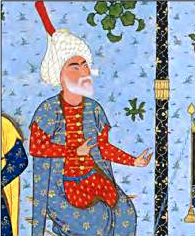
Kavad I was the Sasanian King of Kings of Iran from 488 to 531, with a two or three-year interruption. A son of Peroz I, he was crowned by the nobles to replace his deposed and unpopular uncle Balash.

Angra Mainyu is the Avestan-language name of Zoroastrianism's hypostasis of the "destructive spirit/mentality" and the main adversary in Zoroastrianism either of the Spenta Mainyu, the "holy/creative spirits/mentality", or directly of Ahura Mazda, the highest deity of Zoroastrianism. The Middle Persian equivalent is Ahriman 𐭠𐭧𐭫𐭬𐭭𐭩.
Saoshyant is the Avestan language expression that literally means "one who brings benefit", and which is used in several different ways in Zoroastrian scripture and tradition. In particular, the expression is the proper name of the Saoshyant, an eschatological saviour figure who brings about Frashokereti, the final renovation of the world in which evil is finally destroyed. The term was contracted to "Soshans" in Zoroastrian tradition, and came to apply to three saviour figures that progressively bring about the final renovation.
Middle Persian literature is the corpus of written works composed in Middle Persian, that is, the Middle Iranian dialect of Persia proper, the region in the south-western corner of the Iranian plateau. Middle Persian was the prestige dialect during the era of Sassanid dynasty.

Jamasp was Sasanian King of Kings of Iran from 496 to 498/9. He was a son of Peroz I and younger brother of Kavad I. Jamasp was installed on the Sasanian throne upon the deposition of the latter by the nobility and clergy.
Iranian philosophy or Persian philosophy can be traced back as far as to Old Iranian philosophical traditions and thoughts which originated in ancient Indo-Iranian roots and were considerably influenced by Zarathustra's teachings. According to the Oxford Dictionary of Philosophy, the chronology of the subject and science of philosophy starts with the Indo-Iranians, dating this event to 1500 BC. The Oxford dictionary also states, "Zarathustra's philosophy entered to influence Western tradition through Judaism, and therefore on Middle Platonism."
This is a family tree of the Sasanian emperors, their ancestors, and Sasanian princes/princesses.

The Jamasp Nameh is a Middle Persian book of revelations. In an extended sense, it is also a primary source on Medieval Zoroastrian doctrine and legend. The work is also known as the Ayādgār ī Jāmāspīg or Ayātkār-ī Jāmāspīk, meaning "[In] Memoriam of Jamasp".

Seeing Islam As Others Saw It: A Survey and Evaluation of Christian, Jewish and Zoroastrian Writings on Early Islam from the Studies in Late Antiquity and Early Islam series is a book by scholar of the Middle East Robert G. Hoyland.

Maneckji Nusserwanji Dhalla, also abbreviated M. N. Dhalla, was a Pakistani Zoroastrian priest and religious scholar.

The Kayanians are a legendary dynasty of Persian tradition and folklore which supposedly ruled after the Pishdadians. Considered collectively, the Kayanian kings are the heroes of the Avesta, the sacred texts of Zoroastrianism, and of the Shahnameh, Iran's national epic.
Ayadgar-i Zareran, meaning "Memorial of Zarer", is a Zoroastrian Middle Persian heroic poem that, in its surviving manuscript form, represents one of the earliest surviving examples of Iranian epic poetry.

The Dabuyid or Gaubarid Dynasty was a Zoroastrian Iranian dynasty that started in the early seventh century as an independent group of rulers, reigning over Tabaristan and parts of western Khorasan. Dabuyid rule over Tabaristan and Khorasan lasted from ca. AD 642 to the Abbasid conquest in 760.
This is an alphabetical list of topics related to Zoroastrianism. This list is not complete, please add more to it as needed.
Gushnaspdād, known in Byzantine sources as Gousanastadēs (Γουσαναστάδης), was a Sasanian nobleman, who was kanarang during the reign of Balash, and Kavad I.

Arjāsp is a Turanian king in Shahnameh, the national epic of Greater Iran. Iranica mentions him as a chief of an ancient Iranian tribe named Xyōns. He is son of Shavāsp, the brother of Afrasiab. However, the unknown author of Moǰmal al-tavārikh mentions him as a grandson of Afrasiab, and Bal'ami mentions him as Afrasiab's brother.
Tehran House of Volleyball is a volleyball arena located in Tehran, Iran.
Siyawush, known in Byzantine sources as Seoses (Σεόσης), was an Iranian officer, who served as the head of the Sasanian army (arteshtaran-salar) during the second reign of the Sasanian king (shah) Kavad I. In c. 520, he was accused of purposely misusing peace negotiations with the Byzantine Empire, and was thus removed from power and executed.

Adhar Valash was an Iranian prince from the House of Karen, who ruled Tabaristan and Gurgan under the authority of the last Sasanian emperor Yazdegerd III.
Jamasp was a 6th-century Sasanian prince, who was the second oldest son of the incumbent king (shah) Kavad I. Jamasp was greatly admired for his ability in war, but was disqualified from succession due to have having lost an eye. The following year after the accession of his brother Khosrow I, Bawi along with other members of the Iranian aristocracy, became involved in a conspiracy in which they tried to overthrow Khosrow and make Jamasp's son Kavad the new shah, so Jamasp could rule as regent. The conspiracy, however, was revealed and Jamasp was murdered.












